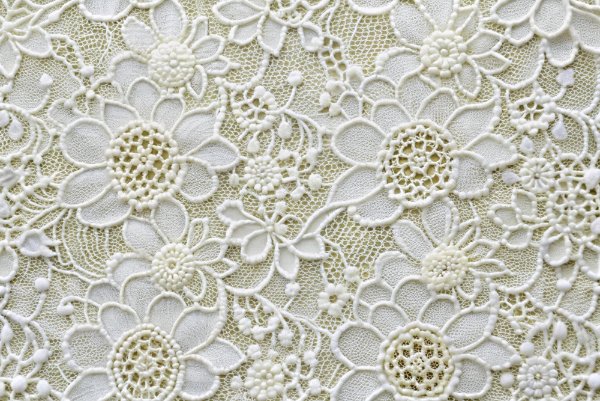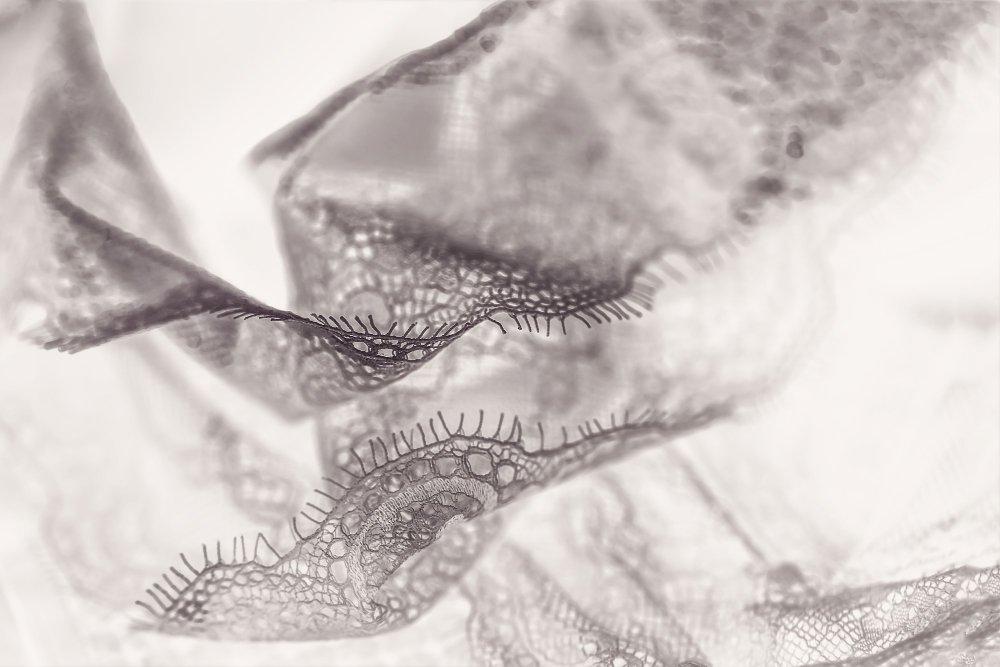Your Complete 2025 Guide to Embroidered Lace: Types, Care, and Expert Buying Tips
Have you ever wondered why some embroidered lace costs more than designer handbags? Premium textiles can reach up to $450 per yard, transforming ordinary sewing projects into runway-worthy masterpieces. This level of craftsmanship represents hours of intricate hand-stitching that combines traditional techniques with modern innovation.
When you’re working with embroidered lace, you’re handling one of fashion’s most elegant materials. The raised floral motifs and metallic accents create depth that machines simply can’t replicate. Whether you’re planning a wedding dress or updating your home decor, understanding these luxurious fabrics will help you make the perfect choice for your project.
Table of Contents
What Is Embroidered Lace Fabric?
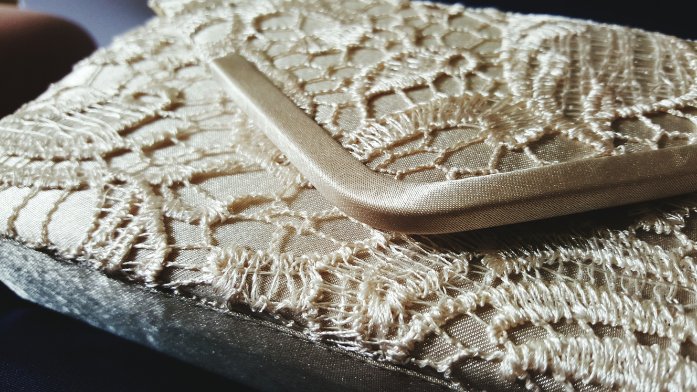
Embroidered lace fabric is a decorative textile that features intricate patterns stitched directly onto a base material, typically lace fabric or mesh. This technique creates dimensional designs that stand out from the surface, giving the fabric texture and visual interest.
The embroidery process involves adding threads, beads, sequins, or other embellishments to create floral motifs, geometric patterns, or abstract designs. Modern embroidered lace often combines machine precision with hand-finished details, resulting in fabrics that offer both beauty and durability.
According to the International Lace Society, proper identification of lace types requires understanding both construction methods and historical origins, which helps crafters select appropriate materials for their specific projects.
What Is Embroidered Lace Called?
Embroidered lace goes by several names depending on the specific technique and style:
- Appliqué lace when embroidered pieces are sewn onto the base fabric
- Raised embroidery lace for three-dimensional designs
- Beaded lace when incorporating pearls, crystals, or glass beads
- Corded lace featuring raised threads that outline patterns
- 3D floral lace for lifelike botanical motifs
What Is Embroidered Material Called?
Different types of embroidered materials have specific names based on their construction and appearance:
- Puff embroidery (also called 3D embroidery) creates raised designs using foam underneath the stitching.
- Re-embroidered lace involves adding new embroidery over existing lace patterns for extra dimension.
- Floral lace specifically refers to designs featuring flowers, leaves, and botanical elements.
The “fuzzy embroidery” you might see is typically chenille embroidery, which uses soft, textured threads that create a plush, velvety appearance.
Types of Embroidered Lace Fabric
Understanding the different varieties helps you choose the right material for your specific project needs. Each type offers unique characteristics in terms of weight, drape, and visual impact.
The Smithsonian’s textile collection demonstrates how embroidered lace techniques have evolved from 16th-century European handcraft to modern machine production, resulting in the diverse varieties available today
Not sure what type of embroidered lace you’re working with? This simple flowchart will help you identify your lace in just a few steps. Grab your fabric sample and follow along:
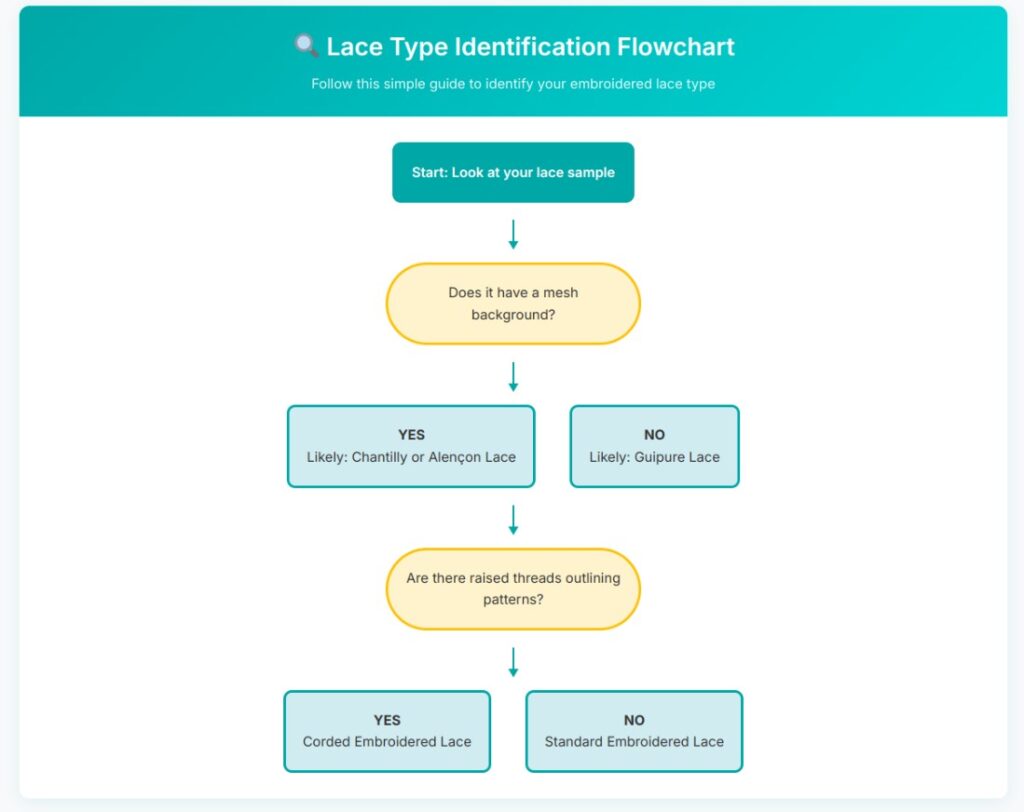
Now that you know what type of embroidered lace you have, let’s dive deeper into each variety’s unique characteristics and best applications
Guipure Embroidered Lace
Guipure lace fabric stands out with its bold, three-dimensional patterns that don’t rely on mesh backing. The embroidered elements connect through fine threads, creating dramatic openwork effects. This makes guipure perfect for structured garments like fitted bodices or statement sleeves.
Modern guipure features raised floral medallions and geometric shapes that work well in both traditional and contemporary designs. The substantial weight of this fabric provides excellent structure for formal wear.
Chantilly Embroidered Lace
Chantilly lace fabric embodies French craftsmanship with delicate floral motifs on fine mesh backgrounds. The scalloped edges and romantic patterns make it ideal for bridal wear and evening gowns. When embroidered with metallic threads, Chantilly lace takes on a luxurious contemporary appeal.
The lightweight nature of Chantilly makes it perfect for overlays, veils, and flowing garments that need movement and grace.
Corded Embroidered Lace
Corded lace fabric uses raised threads to outline embroidered designs, adding depth and definition. The Marchesa Double-Scalloped pattern demonstrates how these details enhance bridal wear with defined edges that make patterns pop.
This type works exceptionally well for statement pieces where you want the embroidered elements to be clearly visible and tactile.
Beaded Embroidered Lace
Beaded lace fabric incorporates pearls, crystals, sequins, or glass beads into the embroidered design. These embellishments catch light beautifully, making them popular for evening wear and formal occasions.
French designs often combine metallic threads with caviar beading for multi-dimensional effects that create movement and sparkle under lights.
Material Composition and Blends
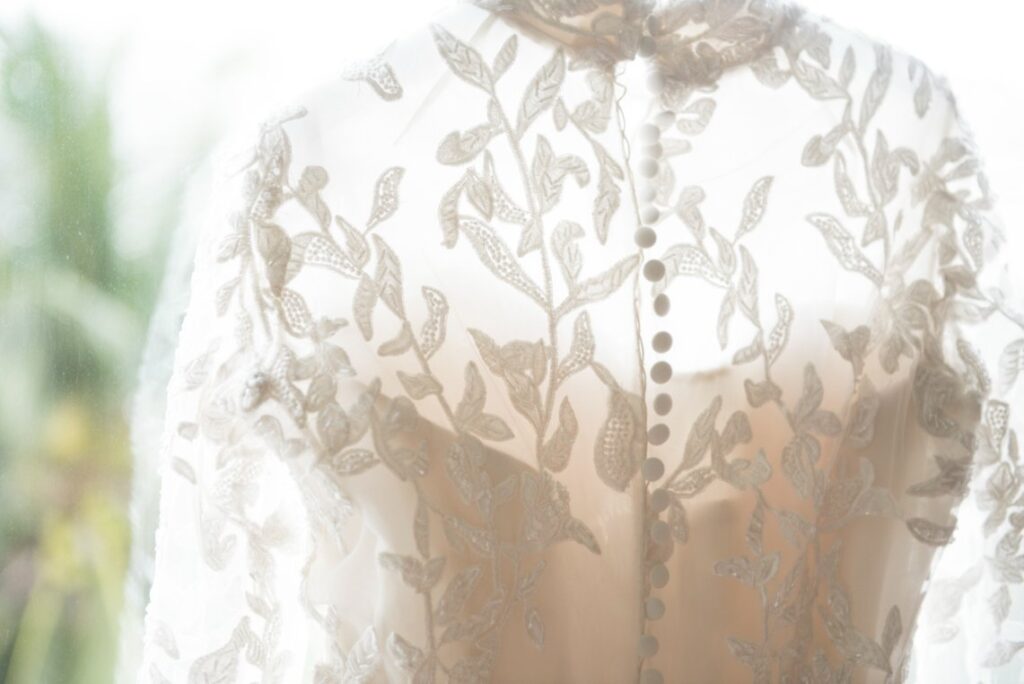
The base material significantly affects how your embroidered lace will look, feel, and perform in your finished project.
Polyester Blends
Polyester-based embroidered lace offers several practical advantages. These fabrics resist wrinkles and fading while maintaining vibrant colors through multiple washes. Cotton vs polyester fabric comparisons show that polyester blends provide excellent durability for high-use applications.
You’ll find polyester embroidered lace in widths up to 55 inches, making it suitable for large projects without seaming. The material works well for:
- Evening dresses that need frequent cleaning
- Home decor items like curtains and table linens
- Costume pieces requiring durability
- Projects on a budget without sacrificing quality
Natural Fiber Blends
Cotton fabric and silk blends provide luxurious drape and breathability that synthetic materials can’t match. These natural vs synthetic fabrics offer superior comfort for items worn close to the skin.
Natural fiber embroidered lace excels in:
- Bridal gowns requiring all-day comfort
- High-end fashion pieces
- Heirloom items meant to last generations
- Projects where natural feel matters most
Features That Make Embroidered Lace Special
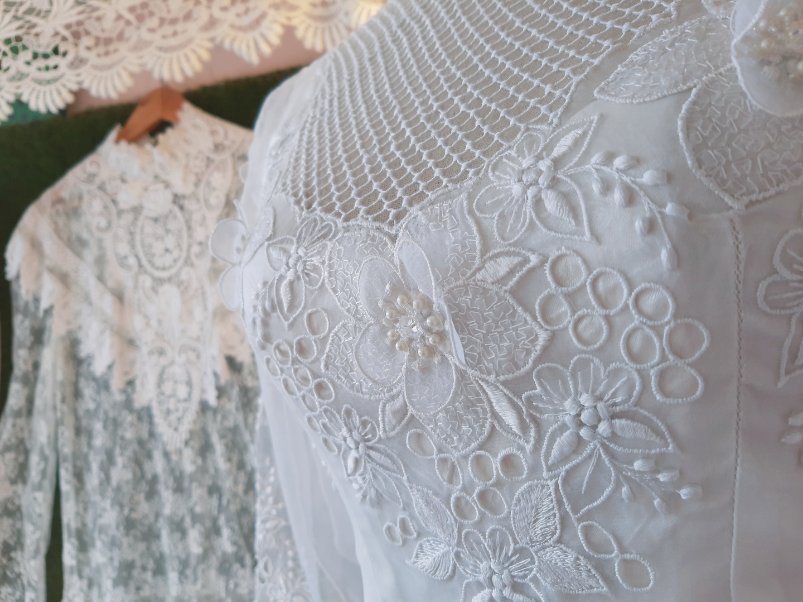
The magic of embroidered lace lies in its surface details that transform flat fabric into a tactile masterpiece.
Three-Dimensional Stitching
Modern embroidered lace techniques layer threads to create raised petals and leaves that seem to float above the base material. These dimensional elements catch light and create shadows that change as the wearer moves.
Geometric medallions contrast beautifully with flowing vine patterns, offering versatility for both contemporary and traditional design styles.
Elegant Embellishments
Glass beads act like miniature prisms, breaking light into beautiful sparkles throughout the fabric. Pearls add refined texture, while sequins create movement in evening wear. French designs often feature:
- Metallic threads in gold, silver, and rose gold
- Caviar beading for subtle texture
- Crystal accents for formal wear
- Pearl embellishments for bridal pieces
Color Options and Finishes
Today’s embroidered lace breaks free from traditional white and ivory. You’ll find over 65 color options including:
- Rose gold threads on coral bases
- Navy backgrounds with silver highlights
- Metallic finishes that maintain delicate appeal
- Shimmer coatings for special effects
- Flocked textures for unexpected visual interest
2025 Trends in Embroidered Lace
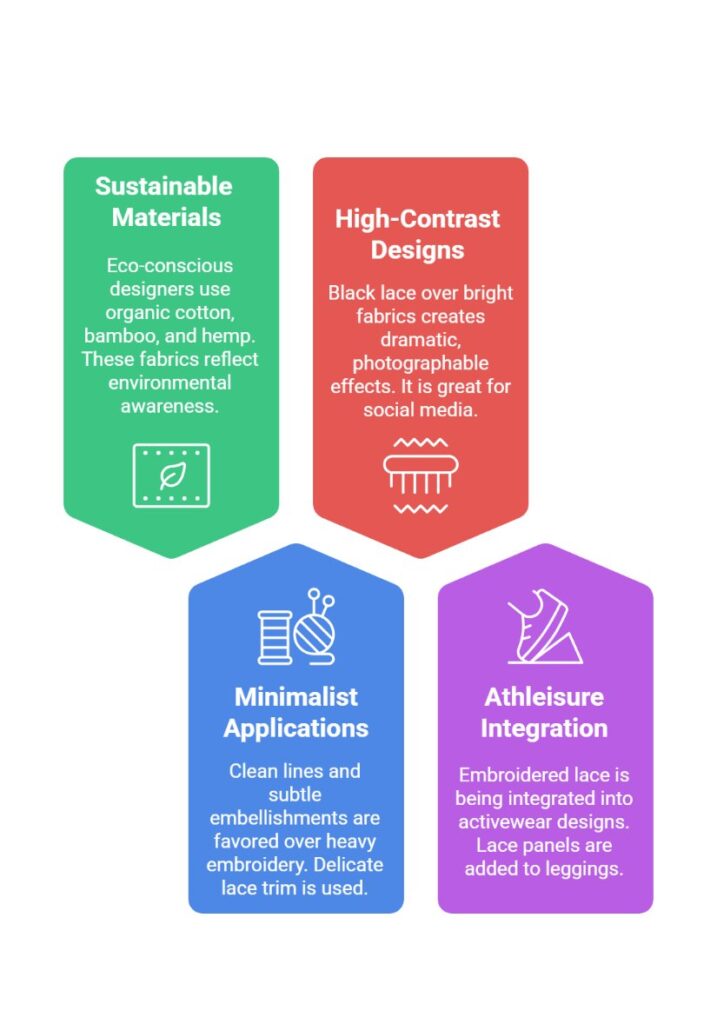
The embroidered lace market continues evolving with fresh approaches that blend tradition with innovation.
Sustainable Materials
Eco-conscious designers are embracing organic cotton lace, bamboo blends, and hemp-based options. These 2025 fabric trends reflect growing environmental awareness while maintaining the quality and beauty of traditional lace.
Minimalist Applications
Rather than heavy, ornate embroidery, 2025 trends favor clean lines and subtle embellishments. Think delicate lace trim on blazers or simple floral motifs on everyday wear.
High-Contrast Designs
Black lace over bright-colored fabrics creates dramatic effects that photograph beautifully. This trend works especially well for social media and special events.
Athleisure Integration
Embroidered lace is making its way into activewear with lace-paneled leggings and sports bras that blend femininity with function.
Can You Embroider on Lace Fabric?
Yes, you can add embroidery to existing lace fabric, though it requires careful technique and the right tools. This process, called re-embroidering, allows you to customize or enhance lace pieces.
Best Practices for Embroidering Lace:
- Use the right stabilizer: Place water-soluble stabilizer behind the lace to prevent puckering
- Choose appropriate needles: Sharp embroidery needles work best for precise stitching
- Select suitable threads: Match thread weight to the lace’s delicate nature
- Plan your design: Work with the existing lace pattern rather than fighting against it
When to Avoid Embroidering Lace:
- Vintage or delicate antique pieces
- Very fine mesh that might tear
- Heavily beaded lace where needles can’t penetrate easily
- Projects where the existing pattern is perfect as-is
Buying Guide: Choosing the Right Embroidered Lace
Making smart purchases starts with understanding what to look for and how different factors affect price and quality.
Quality Assessment Checklist
- Stitch Density: Look for 12-14 stitches per centimeter in premium pieces. Consistent spacing indicates quality construction.
- Thread Quality: High-end embroidered lace uses colorfast threads that won’t bleed or fade. Test a small corner if possible.
- Base Fabric: The foundation should feel substantial enough to support the embroidery without tearing.
- Embellishment Security: Beads and sequins should be firmly attached. Loose elements indicate rushed construction.
Learning to spot quality embroidered lace takes practice, but these visual indicators make it much easier. Use this reference guide when shopping in-store or online to ensure you’re getting the best value for your money:
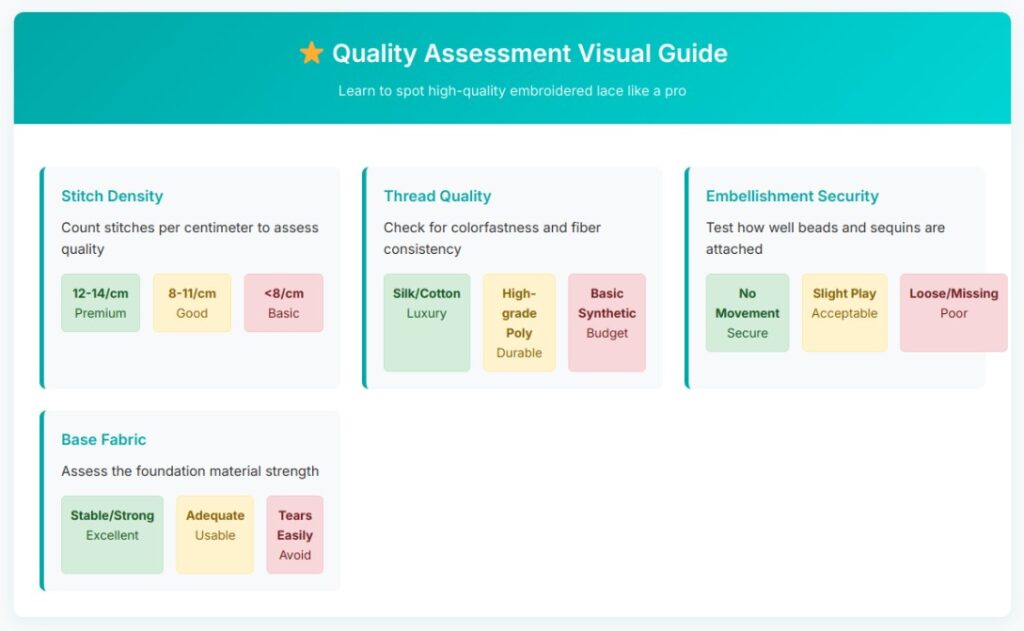
Keep these quality markers in mind as we explore how pricing relates to value across different lace types. Remember, the most expensive option isn’t always the best choice for your specific project
Price-to-Value Comparison
| Lace Type | Price Range | Best For | Value Rating |
|---|---|---|---|
| Machine embroidered polyester | $20-45/yard | Home decor, casual wear | High |
| Hand-finished cotton blend | $60-120/yard | Special occasion wear | Good |
| French artisan lace | $200-450/yard | Couture, heirloom pieces | Premium |
| Beaded evening lace | $80-200/yard | Formal wear, bridal | Good |
Choosing between different embroidered lace types can feel overwhelming. This comparison chart breaks down the key factors to help you make the best decision for your project and budget:
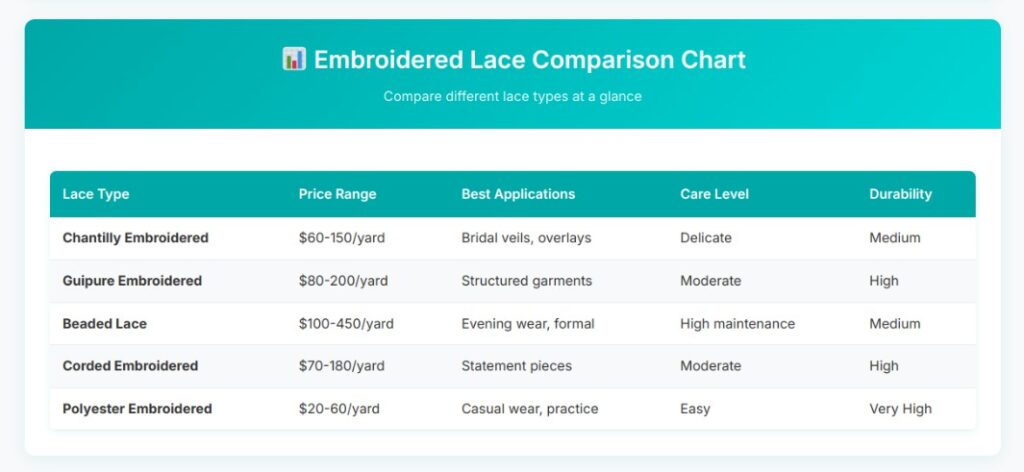
This overview gives you the big picture, but your specific project needs will ultimately guide your choice. Let’s look at recommendations for different types of projects.
Project-Specific Recommendations
- Bridal Gowns: Choose Alençon lace fabric or Chantilly with subtle embellishments. Budget 4-6 yards for most designs.
- Evening Wear: Beaded or sequined embroidered lace creates stunning effects under lights. 2-3 yards typically suffices.
- Home Decor: Polyester blends offer durability and easy care for curtains, pillows, and table linens.
- Craft Projects: Smaller pieces let you experiment with expensive laces without major investment.
Complete Care Guide for Embroidered Lace
Proper care ensures your embroidered lace maintains its beauty for years. Different materials and embellishments require specific approaches.
Pre-Cleaning Assessment
Always check care labels first. Some embroidered lace specifies dry-clean only, especially pieces with metallic threads or delicate beading. When in doubt, test cleaning methods on a hidden area.
Proper care starts with choosing the right cleaning method for your specific lace type. Save or print this quick-reference guide to keep handy whenever you need to clean your embroidered lace items:
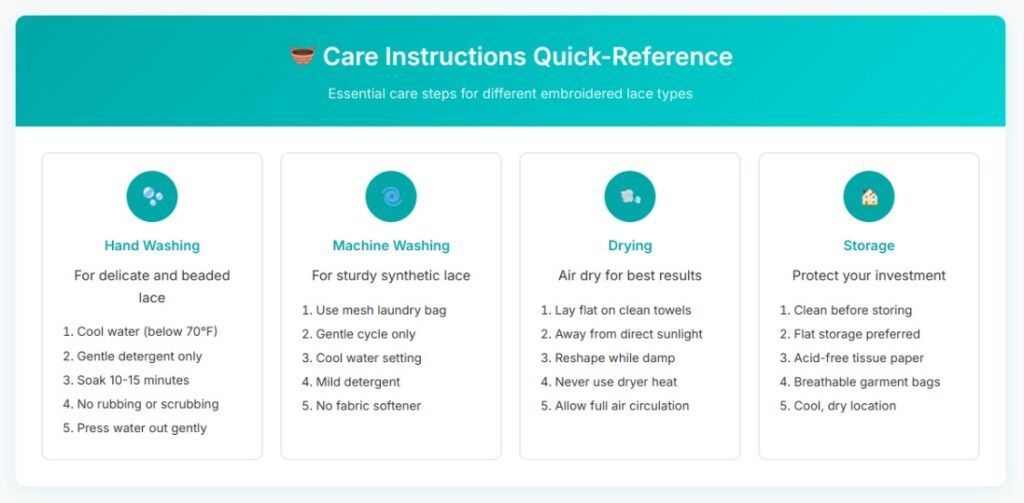
These care cards provide the essential steps, but every lace is unique. Let’s explore the detailed methods to ensure you’re caring for your specific embroidered lace correctly.
Hand Washing Method
Step 1: Fill a basin with cool water (below 70°F) and add gentle detergent designed for delicates.
Step 2: Submerge the lace gently, allowing it to soak for 10-15 minutes without agitation.
Step 3: Swish the fabric carefully through the water. Never rub or scrub embroidered areas.
Step 4: Rinse thoroughly with cool water until no soap remains.
Step 5: Press out excess water gently between clean towels. Never wring or twist.
Machine Washing Guidelines
Modern synthetic embroidered lace can often handle machine washing with proper precautions:
- Use mesh laundry bags to protect delicate embellishments
- Select the gentle cycle with cool water
- Choose mild detergent without bleach or fabric softener
- Wash alone or with similar delicate items only
Drying Best Practices
- Air drying is always safest. Lay flat on clean towels away from direct sunlight. For hanging, use padded hangers to prevent stretching.
- Never use the dryer for embroidered lace. Heat can melt synthetic embellishments and distort delicate fibers.
Ironing and Steaming
- Use low heat settings and place a pressing cloth between the iron and lace
- Steam carefully to avoid water spots on metallic elements
- Press from the wrong side when possible to protect surface embellishments
- Avoid the iron tip catching in openwork areas
Storage Solutions
- Flat storage works best for large pieces. Use acid-free tissue paper between folds.
- Padded hangers suit lighter garments but avoid hanging heavy beaded pieces.
- Breathable garment bags protect from dust while allowing air circulation.
- Cool, dry locations prevent mold and mildew in humid climates.
Stain Removal
- Act quickly on spills before they set
- Blot, don’t rub to avoid pushing stains deeper
- Use specialized fabric cleaners designed for delicate textiles
- Professional cleaning may be necessary for valuable pieces
Common Problems and Solutions
Even with careful handling, issues can arise with embroidered lace. Here’s how to address common problems:
Snagged Embroidery
Small snags often can be carefully worked back into place with a needle. For larger damage, consider professional repair services that specialize in delicate textiles.
Loose Beads or Sequins
Secure loose embellishments promptly to prevent further loss. Use matching thread and tiny stitches that won’t show on the right side.
Color Bleeding
If metallic threads bleed onto the base fabric, stop washing immediately. Professional cleaners have specialized techniques for treating color bleeding.
Shrinkage
Prevention is key since stretched lace rarely returns to original dimensions. Always test wash a sample piece when working with new materials.
Project Applications and Inspiration
Embroidered lace transforms ordinary projects into extraordinary creations across multiple applications.
Successful embroidered lace projects start with good planning. Use this interactive worksheet to organize your project details, calculate costs, and ensure you haven’t missed any important steps:

With your project planned and budget calculated, you’re ready to explore specific applications. The following sections will give you detailed guidance for different project types, from bridal wear to home decor
Bridal and Special Occasion Wear
Wedding Gowns: Guipure lace creates dramatic bodices while Chantilly offers romantic overlays. Consider embroidered lace for:
- Statement sleeves with 3D floral motifs
- Delicate trim on simple silhouettes
- Full overlays on A-line skirts
- Custom appliqués for personalized touches
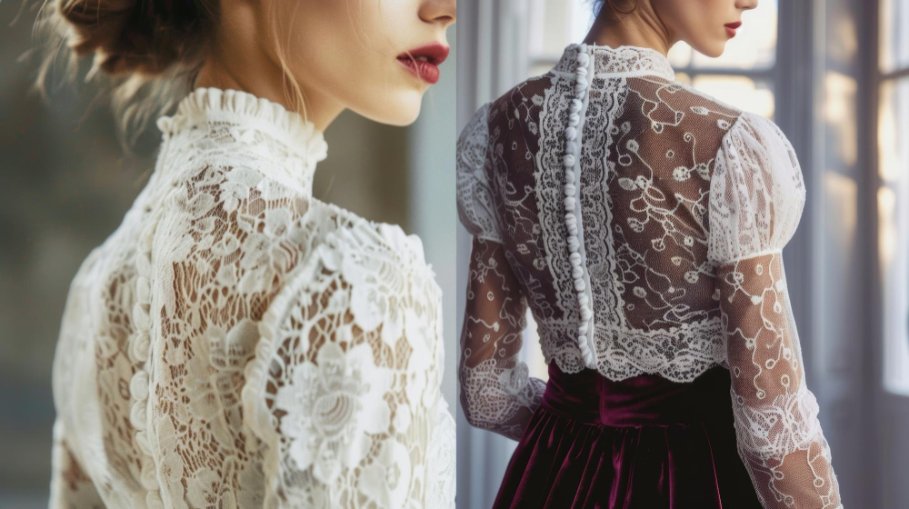
Evening Wear: Beaded embroidered lace catches light beautifully for formal events. Popular applications include:
- Cocktail dress overlays
- Statement panels on solid fabrics
- Elegant trim on necklines and hems
- Full-coverage designs for galas
Home Decor Projects
- Table Linens: Embroidered lace elevates dining experiences. Cotton fabric bases with delicate embroidery work well for everyday use, while beaded options suit special occasions.
- Window Treatments: Light, airy embroidered lace creates beautiful filtered light effects while maintaining privacy.
- Accent Pillows: Small amounts of luxury lace can transform simple pillows into designer pieces.
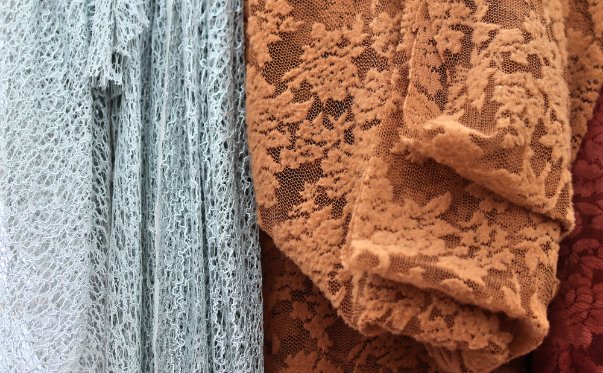
Garment Construction Tips
- Seaming: Use French seams or bound edges to protect delicate embroidery from fraying.
- Interfacing: Choose lightweight, non-fusible interfacing to avoid damaging embellishments with heat.
- Pressing: Always test press scraps first to determine safe temperature settings.
- Pattern Layout: Plan placement carefully to showcase embroidered motifs in flattering positions.
Cost-Saving Strategies
Quality embroidered lace doesn’t always require premium prices with smart shopping approaches.
Timing Your Purchases
- End-of-season sales often feature significant discounts on formal fabrics
- Bridal sample sales may include embroidered lace at reduced prices
- Fabric store clearances offer opportunities for building your stash
Alternative Sources
- Remnant pieces work well for smaller projects and testing new techniques
- Online marketplaces sometimes feature destash sales from other sewers
- Wholesale suppliers offer bulk pricing for larger projects
Maximizing Your Investment
- Plan multiple projects to justify expensive lace purchases
- Combine with simpler fabrics to stretch your budget further
- Consider trim applications rather than full yardage for budget-friendly elegance
Troubleshooting Guide
When problems arise with embroidered lace projects, quick action often prevents permanent damage.
During Construction
- Needle breaks frequently: Switch to a sharp needle designed for embroidered fabrics
- Embellishments snag on presser feet: Use a special embroidery foot or hand-baste problem areas
- Puckering occurs: Reduce tension and use appropriate stabilizers
After Completion
- Wrinkles set in storage: Steam gently or use professional pressing services
- Colors fade: Store away from light and avoid harsh cleaning chemicals
- Embellishments tarnish: Clean with appropriate metal cleaners designed for textiles
Quality vs. Price: Making Smart Investments
Understanding what drives embroidered lace pricing helps you make informed decisions that balance budget with quality needs.
Factors Affecting Price
- Hand vs. machine work: Hand-embroidered pieces command premium prices due to labor intensity
- Thread quality: Silk and metallic threads cost more than synthetic alternatives
- Base fabric: Natural fibers typically price higher than synthetic options
- Embellishment density: More beads, sequins, or complex embroidery increase costs
- Country of origin: European and artisan-made pieces often carry premium pricing
When to Splurge
- Heirloom pieces meant to last generations justify higher investment
- Wedding gowns and special occasion wear benefit from premium materials
- Showcase projects where quality differences will be noticed
- Small yardage needs where the total cost remains manageable
When to Save
- Practice projects while learning new techniques
- Home decor items that won’t receive close inspection
- Children’s clothing that will be outgrown quickly
- Casual wear where durability matters more than luxury
Working with Different Fabric Weights
Embroidered lace comes in various weights that affect drape, structure, and appropriate applications.
Lightweight Options
Best for flowing garments, overlays, and delicate applications. These work well for:
- Bridal veils and delicate sleeves
- Summer garments requiring breathability
- Layering over other fabrics
- Accessories like scarves and shawls
Medium Weight Choices
Offer good balance of drape and structure for most garment applications:
- Fitted bodices and structured areas
- Standalone garments without lining
- Home decor items needing some body
- Craft projects requiring stability
Heavy Weight Applications
Provide maximum structure and impact for statement pieces:
- Formal evening wear requiring dramatic silhouettes
- Outerwear applications like jackets
- Upholstery and heavy-duty home decor
- Projects where lace serves as the primary structural element
Coordinating Colors and Patterns
Successfully incorporating embroidered lace requires understanding how it interacts with other design elements.
Color Harmony
- Monochromatic schemes using varying shades of the same color create sophisticated looks
- Complementary colors make embroidered elements pop against contrasting backgrounds
- Neutral bases allow intricate embroidery to take center stage
- Metallic accents add richness without overwhelming delicate patterns
Pattern Mixing
- Scale variation prevents competing patterns from clashing
- Similar color palettes unify different pattern types
- Solid buffers provide visual rest between busy embroidered areas
- Texture contrast adds interest without pattern complexity
Future Care and Maintenance
Long-term care strategies preserve your embroidered lace investments for years of enjoyment.
Seasonal Storage
- Clean before storing to prevent stains from setting during storage
- Use breathable materials like cotton garment bags rather than plastic
- Add lavender sachets for natural pest deterrence
- Check periodically for any developing issues
Professional Services
- Annual cleaning for frequently worn items maintains appearance
- Restoration services can address aging or damage in valuable pieces
- Preservation techniques help maintain heirloom items for future generations
Conclusion
Embroidered lace fabric represents the perfect marriage of traditional artistry and modern innovation. Whether you’re investing in a $450 French couture piece or working with budget-friendly polyester options, understanding the different types, care requirements, and applications ensures you’ll make choices that serve your projects beautifully.
The key takeaways for working with embroidered lace include choosing the right type for your specific project needs, implementing proper care techniques from the start, and recognizing when to invest in premium materials versus when to save. Remember that even affordable embroidered lace can create stunning results when selected and handled appropriately.
As 2025 trends continue emphasizing sustainability and versatility, embroidered lace adapts to meet modern needs while maintaining its timeless appeal. From minimalist applications to bold statement pieces, this fabric continues evolving to serve both traditional and contemporary design visions.
For your next project, consider how embroidered lace might elevate your creation from ordinary to extraordinary. Whether crafting a once-in-a-lifetime bridal gown or adding elegant touches to everyday items, these beautiful fabrics offer endless possibilities for creative expression. Take time to understand your options, invest in proper care techniques, and enjoy the lasting beauty that quality embroidered lace brings to any project.
Most importantly, remember that working with embroidered lace is about more than just the technical aspects. These fabrics carry centuries of textile tradition while embracing modern innovation. Each piece you create becomes part of that continuing story, connecting you to the artisans who developed these techniques and the future craftspeople who will continue evolving this beautiful art form.

